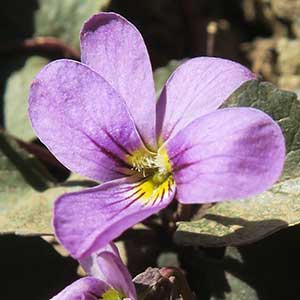Viola flettii
Viola palmata
Flett's violet, Olympic violet, rock violet
early blue violet, three-lobe violet, three-lobed violet, trilobed violet, wood violet
1–3, ascending to erect, mostly glabrous, on caudex from fleshy rhizome.
basal and cauline;
basal: 1–3;
stipules linear-lanceolate, margins entire or with glandular processes, apex acuminate;
petiole 1.5–9.7 cm, mostly glabrous;
blade purple-tinted and –veined, broadly reniform to ovate, 0.9–2.4 × 1.2–4 cm, base cordate, margins finely crenate-serrate, eciliate, apex acute to obtuse, surfaces glabrous or sparsely pubescent along veins adaxially;
cauline similar to basal except: stipules ovate to lanceolate, margins entire or shallowly laciniate;
petiole 0.7–5.9 cm, usually glabrous;
blade 0.8–2.1 × 1.2–3.1 cm.
basal, 2–3, ascending to erect;
stipules linear-lanceolate, margins entire, apex acute;
petiole 1–20 cm, glabrous or pubescent;
earliest leaf blades unlobed, mid-season blades 3–9-lobed, lobes sometimes appearing petiolate and sometimes further lobed;
earliest leaf blades reniform to ovate, mid-season blades with middle lobes usually ovate or elliptic to widely obovate, sometimes narrowly elliptic, narrowly ovate, lanceolate, or spatulate to narrowly obovate, lateral lobes elliptic, obdeltate, or spatulate to falcate, smaller lobes similar, 1–14 × 1–10 cm, base truncate to cordate, margins serrate or entire, usually ciliate, apex acute, rounded, blunt, or obtuse, surfaces glabrous or pubescent throughout or along veins.
1.8–7.1 cm, usually glabrous.
3–13 cm, glabrous or pubescent.
sepals lanceolate, margins eciliate, auricles 0.5–1.5 mm;
petals soft reddish violet on both surfaces, all with yellow area basally, lower 3 dark violet-veined, lateral 2 bearded, lowest with white around yellow area, 10–15 mm, spur yellow, gibbous, 0.5–2 mm;
style head bearded; cleistogamous flowers axillary.
sepals lanceolate, margins ciliate or eciliate, auricles 0.5–1 mm;
petals violet on both surfaces, lower 3 white basally, lower 3 and upper 2 sometimes purple-veined, lateral 2 bearded, spur sometimes bearded, lowest 15–25 mm, spur white, gibbous, 2–3 mm;
style head beardless; cleistogamous flowers on prostrate to ascending peduncles.
± spherical, 5–9 mm, glabrous.
ellipsoid, 5–15 mm, glabrous.
dark brown to brownish purple, 2.5–3 mm.
beige, mottled to bronze, 1.5–2.5 mm.
= 54.
Viola flettii
Viola palmata
Viola flettii is endemic to the Olympic Mountains of northwestern Washington. C. S. McCreary (2005) noted that although morphologically and ecologically distinct, V. cuneata, V. flettii, and V. ocellata are closely related.
(Discussion copyrighted by Flora of North America; reprinted with permission.)
N. L. Gil-Ad (1997) presented evidence based on seed coat micromorphology that some plants known as Viola palmata are hybrids between plants with lobed and unlobed leaves and believed the type specimen to be hybrid in origin. He chose not to recognize the name V. palmata, choosing instead to recognize V. triloba. If the type specimen does represent a hybrid, Gil-Ad would be correct in recognizing V. triloba. Because the purity of the type specimen cannot be ascertained, we consider V. palmata the most appropriate name for this taxon. We acknowledge the presence of hybrids between lobed and unlobed plants; such hybrids obscure lines of demarcation. Some herbarium specimens may represent such hybrids; we feel most do not.
L. E. McKinney (1992) described the nomenclatural history of Viola palmata. Homophylly versus heterophylly differentiates V. palmata from V. subsinuata, the homophyllous violet most often called V. palmata. We know that the taxon described by Linnaeus was heterophyllous, with some undivided leaf blades.
Varieties 2 (2 in the flora).
(Discussion copyrighted by Flora of North America; reprinted with permission.)
1. Petioles, leaf surfaces, and peduncles usually pubescent, rarely glabrous; apex of middle leaf lobe acute; plants of dry to mesic habitats. | var. palmata |
1. Petioles, leaf surfaces, and peduncles usually glabrous, rarely pubescent; apex of middle leaf lobe rounded, blunt, or obtuse; plants of wet ground. | var. heterophylla |


